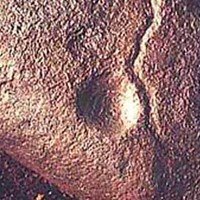SailingCyclops wrote:otseng wrote: Let’s look at the art from your source.
It claims “The oldest known art of prehistory. A cupule at the Auditorium Cave at Bhimbetka, Madhya Pradesh, India. It dates from (290,000-700,000 BCE).”
It is disputable that this would be considered art, or even made from man.
Not disputed actually.
Cupules
From your source, even they are a bit ambiguous if it is considered to be “art”.
Are Cupules a Genuine Type of Art?This question is based upon the rather dubious assumption that we know what art is. Allowing for the moment that we do, our definition of art would certainly be wide enough to include a non-utilitarian cultural activity practised worldwide by people of almost every race and colour. Its ubiquity alone, never mind the huge effort required, commands our attention. One could go further and say that cupule-creation is a much more powerful cultural expression than a pickled tiger shark or a skull decorated with platinum and diamonds, both of which are icons of contemporary art, courtesy of Damien Hirst.
The last word on the subject belongs to Bednarik himself who admits that he finds it “difficult to see [cupules] as an artefact of our taxonomy.” Our only option, he says, is to “consider them as the surviving traces of specific behaviour patterns. In some form or fashion, they represent an endeavour of penetrating into rock in a very specific way”.
Also, the amount of time and effort to produce even one cupule is amazing.
Cupule 1, worked to a depth of 1.9 mm, required 8,490 blows involving 72 minutes of actual working time. Cupule 2, worked to a depth of 4.4 mm, required 8,400 blows involving 66 minutes of actual working time, before the tester reached exhaustion. Cupule 3 required 6,916 strikes to reach a depth of 2.55 mm; Cupule 4 took 1,817 strikes to attain a depth of 0.05 mm (then abandoned); Cupule 5 required 21,730 blows and reached a depth of 6.7 mm.
And this is just for one cupule. The article states finding over 500 cupules in one location.
“Given that Daraki-Chattan has over 500 cupules, one can readily appreciate the serious nature of the endeavour.Cupule-making was no trivial exercise – at least not where hard stone was involved.”
And what exactly is the meaning or intent behind a cupule? And why do not recent people create cupules as art?
As the source states “No paleo-expert has yet produced a convincing explanation of the cultural or artistic meaning of cupules: nor should we expect one.”
And as you stated, it is found nearly all over the world. Why would groups of people all over the world (most likely with no contact with each other), all decide to pound many small dents into hard rock thousands of times?
Also, it appears that almost all the cupules are perfectly symmetrical. It would require a lot of precision for this to be accomplished by an ancient man.
https://debatingchristianity.com/forum/viewtopic.php?p=325128#p325128

